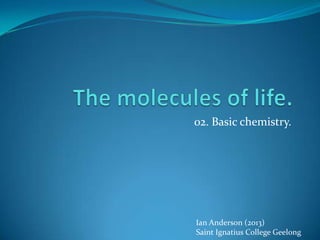
Basic chemistry
- 1. 02. Basic chemistry. Ian Anderson (2013) Saint Ignatius College Geelong
- 2. Knowledge and skills. Distinguish between an atom, an element, a molecule, an ion and a compound. List the important elements found in living organisms. Describe the difference between covalent and ionic bonding. Explain what polar molecules are. Describe how hydrogen bonds may form within or between molecules with polar covalent bonds.
- 3. Atoms. Atoms are the building blocks of all matter. An atom has A central nucleus composed of Positively charged protons. Uncharged (neutral) neutrons. Negatively charged electrons orbitting around the nucleus. The overall charge of an atom is neutral.
- 4. Ions. If an atom gains or loses an electron it becomes a charged ion. Loses one or more electrons positive ion (cation). Gains one or more electron Na Na+ + e- negative ion (anion). H H + + e- The charge of an ion means that it will be attracted to or O+ 2e- O2- will repel other ions (important in ionic bonding).
- 5. Elements. Substances that consist of only one type of atom. Of the 92 naturally occurring elements Only 11 are found in organisms in more than trace amounts. Four of these 11, Carbon (C), hydrogen (H), oxygen (O) and nitrogen (N) make up 99% of Carbon Oxygen organisms by weight. •6 protons •8 protons What makes one element •6 neutrons •8 neutrons different to another is the •6 electrons •8 electrons number of protons its atoms has.
- 6. Molecules and compounds. Molecules = Two or more atoms held together by chemical bonds. e.g. H2, O2, CO2, CH4 O=O Compound = a molecule O2 containing two or more different types of atoms. e.g. CO2, CH4, H2O Note: All compounds are molecules. Not all molecules are compounds!
- 7. Chemical bonding. The atoms that make up a molecule are held together by either Covalent bonds Ionic bonds, or Metallic bonding (not relevant here). Atoms combine with other atoms in order to become more stable. Atoms are most stable when they have a full outer shell [like the noble gases in Gp18].
- 8. Covalent bonding. Only occurs between two non-metals. e.g. O2, CO2, H2O, C6H12O6 Involves the sharing of electrons. Methane (CH4) Covalent bonds are stronger than ionic bonds (generally).
- 9. Ionic bonding. Only occurs between a metal and a non-metal. e.g. NaCl, CaCl2 Involves one atom donating an electron (or electrons) to the other. The two (now) ions are held together by the Sodium chloride electrostatic forces of attraction (NaCl) (one ion has a +ve charge and the other has a –ve charge). Ionic bonds are easier to break than covalent bonds (generally), but are still strong.
- 10. Polar molecules. Sometimes in a covalent bond one Water (H2O) atom attracts the shared electron more strongly than the other atom resulting in unequal sharing of electrons. Even though the overall charge of the molecule is still neutral, there is a slightly positive region and a slightly negative region. The polarity of molecules is an important property. e.g. Polarity governs the way that many molecules cross cell membranes. e.g. H2O, sugars and amino acids.
- 11. Hydrogen bonding. Resulting from the attraction of Water (H2O) δ- the slightly positive hydrogen atom on one polar molecule and the slightly negative atom δ- (usually oxygen or nitrogen) in δ+ δ+ another polar molecule. Only occurs between polar δ+ δ+ molecules. Much weaker than both covalent and ionic bonds. Play an important role wrt the properties of water and the structures of both DNA and proteins.
